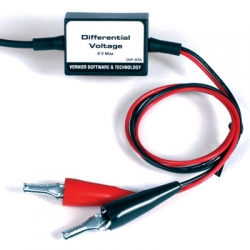
Enlarge

Enlarge
Vernier Differential Voltage Probe
Order code: DVP-BTA
VERNIER DIFFERENTIAL VOLTAGE PROBE
With a range of ±6.0 V this system is ideal for use in "battery and bulb" circuits. Use it with the Current Probe to explore Ohm's law, phase relationships in reactive components and much more. Use multiple Differential Voltage Probes to explore series and parallel circuits.
The Differential Voltage Probe reports the potential difference between the red and black leads. For example, if the black terminal is attached to something that is 2V above ground and the red to something that is 3V below ground, it will report -5 V. The Differential Voltage Probe is the preferred voltage sensor in cases where more than one voltage sensor will be used in the same circuit.
Specifications:
• Input voltage range: ±6.0 V
• Maximum voltage on any input: ±10 V
• Input Impedance (to ground): 10 M Ω
• Differential Impedance: >20 M Ω
• Resolution: 3.1 mV
• Linearity: 0.01%
• Supply voltage: 5 VDC
| User Manual | Vernier Differential Voltage Probe | ||
Educational use only:
Vernier and Kidwind products are designed for educational use. They are not appropriate for industrial, medical or commercial applications. Details
Warranty
- Warranty: 5 years
Dimensions- Package size (HxWxD): 25x127x216mm
- Packed weight: 110g
Last edited 9th Jan 2025
Videos:
 This product is used in teaching these Australian Curriculum codes:
This product is used in teaching these Australian Curriculum codes:
ACSSU190 - Physical Sciences - Energy Conservation - Energy conservation in a system can be explained by describing energy transfers and transformations
ACSPH044 - Thermal nuclear and electrical physics - Electrical circuits - Circuit analysis and design involve calculation of the potential difference across, the current in, and the power supplied to, components in series, parallel and series/parallel circuits
ACSPH039 - Thermal nuclear and electrical physics - Electrical circuits - Energy is conserved in the energy transfers and transformations that occur in an electrical circuit
ACSPH041 - Thermal nuclear and electrical physics - Electrical circuits - Energy is required to separate positive and negative charge carriers; charge separation produces an electrical potential difference that can be used to drive current in circuits
ACSPH042 - Thermal nuclear and electrical physics - Electrical circuits - Power is the rate at which energy is transformed by a circuit component; power enables quantitative analysis of energy transformations in the circuit
ACSPH043 - Thermal nuclear and electrical physics - Electrical circuits - Resistance for ohmic and nonohmic components is defined as the ratio of potential difference across the component to the current in the component
ACSPH040 - Thermal nuclear and electrical physics - Electrical circuits - The energy available to charges moving in an electrical circuit is measured using electric potential difference, which is defined as the change in potential energy per unit charge between two defined points in the circuit
ACSCH103 - Equilibrium acids and redox reactions - Oxidation and reduction - A range of reactions, including displacement reactions of metals, combustion, corrosion, and electrochemical processes, can be modelled as redox reactions involving oxidation of one substance and reduction of another substance
ACSCH104 - Equilibrium acids and redox reactions - Oxidation and reduction - Oxidation can be modelled as the loss of electrons from a chemical species, and reduction can be modelled as the gain of electrons by a chemical species; these processes can be represented using half equations
ACSCH106 - Equilibrium acids and redox reactions - Oxidation and reduction - The relative strength of oxidising and reducing agents can be determined by comparing standard electrode potentials
ACSPH110 - Gravity and electromagnetism - Electromagnetism - A changing magnetic flux induces a potential difference; this process of electromagnetic induction is used in stepup and stepdown transformers, DC and AC generators, and AC induction motors
ACSPH111 - Gravity and electromagnetism - Electromagnetism - Conservation of energy, expressed as Lenz’s Law of electromagnetic induction, is used to determine the direction of induced current
ACSSU155 - Physical Sciences - Energy Forms - Energy appears in different forms, including movement (kinetic energy), heat and potential energy, and energy transformations and transfers cause change within systems
Click a curriculum code to see other products that relate.
| Similar Products: | From |
| GDX-VOLT - Vernier Go Direct Voltage Probe | $236.00 |
| GDX-CUR - Vernier Go Direct Current Probe | $246.00 |
| GDX-NRG - Vernier Go Direct Energy Sensor | $246.00 |
| VP-BTA - Vernier Voltage Probe | $35.00 |
| DCP-BTA - Vernier Current Probe | $122.00 |
| HCS-BTA - Vernier High Current Sensor | $221.00 |
| CRG-BTA - Vernier Charge Sensor | $221.00 |
Documents: Catalogue | Vernier Catalogue K-12 | Catalogue | Vernier Catalogue Uni | Catalogue | Scientrific April 2025 Mini Catalogue | Catalogue | Vernier 2025 K-12 Catalogue | Catalogue | Vernier 2025 University Catalogue | Compatibility Guide | Sensor-Interface-Software Requirements (external link) | Experiment | Electrical Energy | Experiment | Electrical Energy and Power | Experiment | Induction Coil Drop | Experiment | Induction Investigation | Experiment | MC33 Oxidation Reduction | Experiment | MP13 Ohms Law | Experiment | SP33A E-M Induction | Experiment | SP33B Induction Drop | User Manual | Vernier Differential Voltage Probe | | |||||||||||||||||||||||||||||||
Note: Prices do NOT include GST or freight


